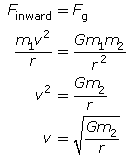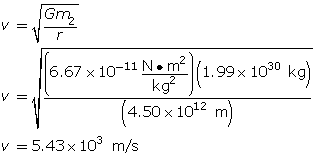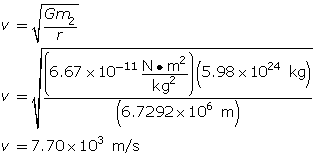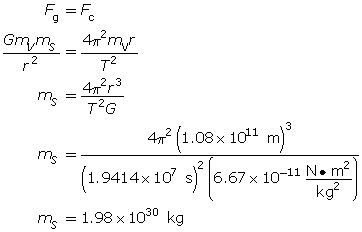Module 5—Circular Motion
 Read
Read
There is an easier way to determine the speed of a satellite. Read pages 276 to 278 of your textbook, starting at “Newton’s Version of Kepler’s Third Law.”
How can you calculate the velocity of a satellite (m1) moving in a perfectly circular orbit? Since the gravitational force is an inward force, it is possible to generate an expression for the velocity of a satellite in a perfectly circular orbit. (If you’re wondering why we chose a circular orbit, it’s because the math is a lot easier than for other types of orbit.)

 Self-Check
Self-Check
SC 4. Answer question 1 of “Practice Problems” on page 278 of the textbook.
 Self-Check Answers
Self-Check Answers
SC 4.
Given
r = 4.50 × 1012 m mS = 1.99 × 1030 kg
Required
the orbital speed of Neptune (v)
Analysis and Solution
Use the equation just derived to calculate the speed.

Paraphrase
The orbital speed of Neptune is 5.43 × 103 m/s.
 Read
Read
Often the position of a satellite is given as altitude above Earth instead of as an orbital radius. Read pages 279 and 280 of your textbook. It is similar to how you have worked with altitude in the Weight and Orbits simulation.
 Self-Check
Self-Check
SC 5. Answer question 1 of “Practice Problems” on page 279 of the textbook.
 Self-Check Answers
Self-Check Answers
SC 5.
Given
h = 359.2 km rE = 6.37 × 106 m mE = 5.98 × 1024 kg
Required
the orbital speed of the International Space Station (v)
Analysis and Solution
Convert the height to metres, and add it to the radius of Earth to get the radius of orbit. Then calculate the speed.
![]()
r = rE + h
= (6.37 × 106 m) + (3.592 × 105 m)
= 6.7292 × 106 m

Paraphrase
The orbital speed of the International Space Station is 7.70 × 103 m/s.
 Module 5: Lesson 4 Assignment
Module 5: Lesson 4 Assignment
Remember to submit the answer to LAB 6 to your teacher as part of your Module 5: Lesson 4 Assignment.
LAB 6. Use the equation derived above to calculate the exact value of the initial speed that will produce a circular orbit of the satellite at an altitude of 1000 km above Earth. Verify your answer using the simulation, and compare it to your answer in LAB 5.
Conclusion
Newton’s universal law of gravitation and the principles of circular motion can be applied to accurately explain the observed motion of planets and satellites.
Equating the inward force and the universal law of gravitation gives an expression for the velocity of an orbiting planet or satellite.
Equating Newton’s second law and the universal law of gravitation gives an expression for the inward acceleration of an orbiting planet or satellite.
By determining the velocity and the acceleration of an orbiting planet or satellite, it is possible to explain the observed orbital motion, which is accurately described by Kepler’s three laws.
 Read
Read
Newton’s law of universal gravitation can give us more information about celestial objects besides their speed in orbit. Read pages 280 to 283 of your textbook, starting at “Determining the Mass of a Celestial Body.”
 Self-Check
Self-Check
SC 6. Answer question 13 from “5.3 Check and Reflect” on page 286 of the textbook.
 Self-Check Answers
Self-Check Answers
SC 6.
Given
mV = 4.87 × 1024 kg
r = 1.08 × 1011 m
T = 224.7 d
Required
the mass of the Sun (mS)
Analysis and Solution
Convert the orbital period to seconds so the units will cancel properly. The inward (centripetal) force is the force of gravity. Equate the formula for centripetal force involving period to the force of gravity, and solve for the mass of the Sun.
![]()

Paraphrase
The mass of the Sun from Venus’ data is 1.98 × 1030 kg.
 Read
Read
Newton’s law of universal gravitation has enabled humankind to successfully launch a myriad of artificial satellites. Read pages 284 to 286 of your textbook, starting at “Artificial Satellites.”